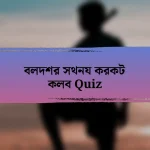Start of বলয়র ধরণসমহ Quiz
1. বোলিংয়ের সবচেয়ে সাধারণ ধরণ কোনটি?
- 5-পিন বোলিং
- ক্যান্ডলপিন বোলিং
- ডাকপিন বোলিং
- 10-পিন বোলিং
2. 10-পিন বোলিংয়ে কয়টি পিন থাকে?
- সাতটি পিন
- দশটি পিন
- নয়টি পিন
- বারোটি পিন
3. 5-পিন বোলিংয়ে ব্যবহৃত বোলিং বলের বিশেষত্ব কী?
- বলের মাপ ছোট এবং হাতে ফিট হয়।
- বলের আকার বড় এবং স্কেটিংয়ের জন্য ব্যবহার করা হয়।
- বলের সঙ্গে ফিঙ্গার হোল থাকে।
- বলের ওজন অনেক বেশি এবং ন্যূনতম ক্রিয়াকলাপে ব্যবহৃত হয়।
4. 5-পিন বোলিংয়ে কয়টি পিন থাকে?
- পাঁচটি পিন
- সাতটি পিন
- দশটি পিন
- তিনটি পিন
5. কোন ধরনের বোলিংয়ে পিনগুলি মোমবাতির মতো আকৃতির?
- বুলেট বোলিং
- কিউব বোলিং
- গ্লাস বোলিং
- মোমবাতি বোলিং
6. কবে ক্যান্ডলপিন বোলিং তৈরি হয়?
- 1975
- 1880
- 1920
- 1905
7. ক্যান্ডলপিন বোলিংয়ে ব্যবহৃত সাধারণ বোলিং বলের ওজন কতো?
- চার পাউন্ড
- তিন পাউন্ড
- প্রায় দুই পাউন্ড
- এক পাউন্ড
8. ক্যান্ডলপিন বোলিংয়ের পিনগুলির বিশেষত্ব কী?
- ক্যান্ডলপিন বোলিং-এর পিনগুলি ভারী এবং সমান আকৃতির।
- ক্যান্ডলপিন বোলিং-এর পিনগুলি ছোট এবং গোলাকার।
- ক্যান্ডলপিন বোলিং-এর পিনগুলি খানিকটা মোটা এবং বোলিংয়ের জন্য অতিরিক্ত শক্তিশালী।
- ক্যান্ডলপিন বোলিং-এর পিনগুলি লম্বা ও চিকন।
9. ডাকপিন বোলিংয়ে প্রতি ফ্রেমে কয়টি পালা থাকে?
- তিন পালা
- দুই পালা
- পাঁচ পালা
- চার পালা
10. ডাকপিন বোলিং কবে আবির্ভূত হয়?
- 1900
- 1880
- 1920
- 1950
11. ডাকপিন বোলিংয়ের একটি খেলায় কয়টি ফ্রেম থাকে?
- আটটি ফ্রেম
- দশটি ফ্রেম
- বারোটি ফ্রেম
- সাতটি ফ্রেম
12. ক্যান্ডলপিন বোলিংয়ের পিনের আকার কেমন?
- চতুর্ভুজ
- ত্রি-বিজ্ঞান
- গোলাকার
- ক্যান্ডলপিন
13. 5-পিন বোলিংয়ের পিনগুলির বিশেষত্ব কী?
- পিনগুলির কিছু অংশ পিছনে থাকে।
- পিনগুলি কাঁটার মতো আকৃতির হয়।
- পিনগুলি খুব বড় এবং ভারী হয়।
- পিনগুলির মাঝ বরাবর রাবার গার্ডল আছে।
14. 5-পিন বোলিং সবচেয়ে বেশি কোথায় খেলা হয়?
- কানাডা
- ভারত
- যুক্তরাষ্ট্র
- অস্ট্রেলিয়া
15. 5-পিন বোলিংয়ে `ভ` আকৃতিতে কয়টি পিন থাকে?
- তিনটি পিন
- সাতটি পিন
- চারটি পিন
- পাঁচটি পিন
16. নাইনে পিন বোলিংয়ের নাম কী?
- পাঁচ পিন বোলিং
- নাইন পিন বোলিং
- দশ পিন বোলিং
- দু-পিন বোলিং
17. নাইনে পিন বোলিংয়ে কয়টি পিন থাকে?
- সাতটি পিন
- আটটি পিন
- নয়টা পিন
- দশটি পিন
18. ক্যান্ডলপিন বোলিংয়ে কয়টি পিন দুটি অনুভূমিক সারিতে সাজানো থাকে?
- পাঁচটি পিন
- আটটি পিন
- এগারোটি পিন
- দশটি পিন
19. পিন বোলিংয়ের ইতিহাসিক খেলা কোনটি?
- ক্যান্ডেল পিন
- নাইনের পিন
- পিন বোলিং
- ডাক পিন
20. লক্ষ্য বোলিংয়ের নাম কী?
- লক্ষ্য বোলিং
- পাঁচ পিন
- ক্যান্ডল পিন
- ডাঙ্ক পিন
21. পিন বোলিংয়ের কিছু সাধারণ ধরন কী কী?
- তিন-পিন
- আট-পিন
- ছয়-পিন
- দশ-পিন, ক্যান্ডলপিন, ডাকপিন
22. ক্যান্ডলপিন বোলিংয়ে বোলিং বলের বিশেষত্ব কী?
- ক্যান্ডলপিন বোলিংতে পড়ে যাওয়া পিন সাফ করা হয় না।
- ক্যান্ডলপিন বোলিংতে পিনগুলি গোলাকার।
- ক্যান্ডলপিন বোলিংতে ব্যবহৃত বল ভারী হয়।
- ক্যান্ডলপিন বোলিংতে পিনগুলি প্রতি ফ্রেমে উড়িয়ে দেওয়া হয়।
23. ডাকপিন বোলিংয়ে ব্যবহৃত বোলিং বলের ওজন কতো?
- 9 আউন্স
- 12 আউন্স
- 7 আউন্স
- 14 আউন্স
24. ডাকপিন বোলিংয়ের পিনগুলির বিশেষত্ব কী?
- ডাকপিন বোলিংতে সাতটি পিন ব্যবহার করা হয়।
- ডাকপিন বোলিংতে তিনটি পিন ব্যবহার করা হয়।
- ডাকপিন বোলিংতে দশটি পিন ব্যবহার করা হয়।
- ডাকপিন বোলিংতে পাঁচটি পিন ব্যবহার করা হয়।
25. ক্যান্ডলপিন বোলিংয়ে সর্বোচ্চ রেকর্ড স্কোর কতো?
- 150
- 300
- 180
- 245
26. 5-পিন বোলিংয়ের পিনগুলিতে কী ধরনের জিনিস থাকে?
- ধাতব গোলা
- রাবার গাঁট
- কাঠের দণ্ড
- প্লাস্টিকের টুকরা
27. ডাকপিন বোলিং কবে আবির্ভূত হয়?
- 1850
- 1900
- 1885
- 1925
28. নাইনে পিন বোলিংয়ে পিনগুলির বিশেষত্ব কী?
- নয়টি পিন
- আটটি পিন
- দশটি পিন
- সাতটি পিন
29. ক্যান্ডলপিন বোলিংয়ে পিনগুলির সাজানো আকার কী?
- ক্যান্ডলপিন বোলিং
- স্নোউপিন বোলিং
- টেনপিন বোলিং
- পাঁচপিন বোলিং
30. ক্যান্ডলপিন বোলিংয়ে কী ধরনের বল ব্যবহৃত হয়?
- ক্যাণ্ডলপিন বোলিং
- অ্যাডভেঞ্চার বোলিং
- দশ পিন বোলিং
- পাঁচ পিন বোলিং
Quiz Completed Successfully!
Congratulations on completing the quiz on ‘বলয়র ধরণসমহ’! We hope you found the experience both enjoyable and enlightening. Engaging with this topic allowed you to delve into the various types of layers and structures we encounter in different contexts. From understanding their characteristics to exploring their significance, you have expanded your knowledge in meaningful ways.
Throughout the quiz, you likely discovered new insights about how these layers function in the world around you. Whether it’s in natural phenomena or in the context of human-made structures, the concept of layers is essential to grasp. This knowledge can enhance your understanding of various disciplines, from geology to architecture, illustrating how interconnected our understanding truly is.
We invite you to continue your learning journey by checking the next section on this page about ‘বলয়র ধরণসমহ.’ There, you’ll find more detailed information that can further enrich your understanding. Dive deeper into this fascinating topic and discover even more about the layers that shape our world!
বলয়র ধরণসমহ
বলয়র ধরণসমহ: একটি পরিচিতি
বলয় একটি জ্যোতির্বিজ্ঞানের উপাদান। সৌরজগতের চারপাশে বিভিন্ন রকমের বলয় দেখা যায়। এগুলো সাধারণত গ্যাস, ধুলো ও কণার মিশ্রণে গঠিত। এর প্রকারভেদ বিভিন্ন চরিত্র ও গঠন অনুযায়ী।
প্রধান বলয়সমূহ
আলোচনা জুড়ে আসা প্রধান বলয়গুলো হল রিং, শাখা, এবং আবিষ্কৃত বলয়। প্রতিটি বলয়ের গঠন ও চরিত্র আলাদা। যেমন, শনি গ্রহের বলয় সবচেয়ে বেশি পরিচিত। এটি বিস্তৃত ও সুন্দর।
বলয়ের গঠন ও উপাদান
বলয় গঠন মূলত সঙ্গতি, ঘনত্ব ও চরিত্রের ওপর নির্ভর করে। এতে প্রতিটি বলয়ের উপাদান ভিন্ন। কিছু বলয়ে পাথর ও বরফ আছে, আবার কিছুতে গ্যাস।
বলয়ের প্রভাব ও গতি
বলয়ের গতি গ্রহের সঙ্গে সম্পর্কিত। এসব বলয় গ্রহের মহাকর্ষের কারণে আকর্ষিত হয়। এই প্রভাবের কারণে বলয়গুলোর গঠনও পরিবর্তিত হয়।
বিজ্ঞানী এবং বলয় গবেষণা
বিজ্ঞানীরা বলয়ের ধরনসমহ নিয়ে গবেষণা করেন। তারা নানান যন্ত্র ব্যবহার করে তথ্য সংগ্রহ করেন। এবিষয়ে নতুন আবিষ্কারগুলো আমাদের জ্ঞান বৃদ্ধি করে।
What are the different types of orbits?
Orbits can be categorized based on their shape and characteristics. The primary types are circular and elliptical orbits. Circular orbits maintain a constant distance from the central body, while elliptical orbits have varying distances, resulting in an eccentric shape. Other types include parabolic and hyperbolic orbits, which are not closed and indicate trajectories of objects not bound to a central body.
How do orbits behave in different celestial systems?
The behavior of orbits varies depending on the gravitational forces and the bodies involved. In our solar system, planets follow elliptical orbits around the sun, while moons orbit their respective planets. The gravitational pull of larger bodies influences the orbits of smaller objects. In binary star systems, two stars can orbit a common center due to mutual gravitational attraction.
Where do we observe circular orbits in nature?
Circular orbits are observed in many natural settings. For example, satellites orbiting Earth often follow circular paths for stability and consistent coverage. Similarly, planets like Earth and Venus have nearly circular orbits around the sun. These stable orbits allow for predictable patterns in movement and seasonal changes.
When do orbits transition from elliptical to parabolic?
Orbits transition from elliptical to parabolic when an object gains enough velocity to escape the gravitational pull of the central body. This occurs at a specific speed known as escape velocity. An object moving at this speed is no longer bound to the body it orbits and adopts a parabolic trajectory, leading to an escape from the orbit.
Who discovered the laws governing planetary orbits?
The laws governing planetary orbits were formulated by Johannes Kepler in the early 17th century. His three laws of planetary motion describe how planets orbit the sun in elliptical paths. Kepler’s work built upon earlier observations by astronomer Tycho Brahe. His findings laid the groundwork for Newton’s law of universal gravitation, providing a comprehensive understanding of celestial mechanics.



